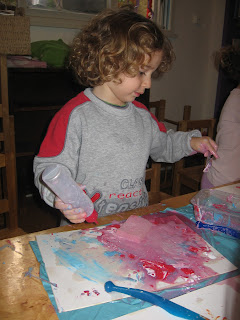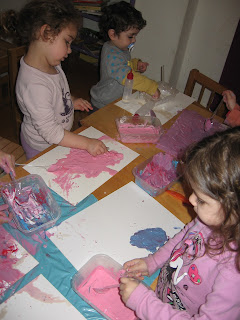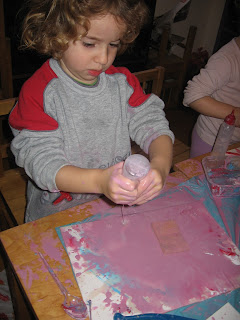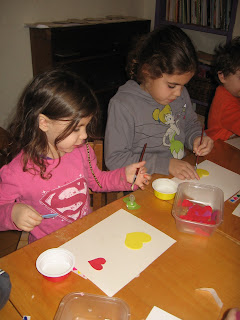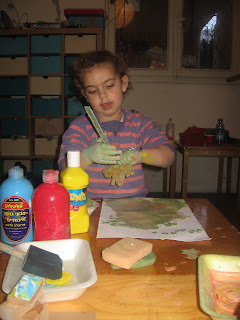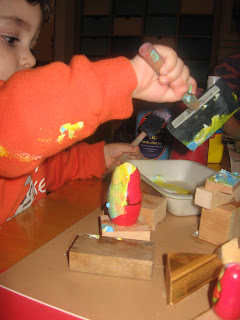Here's what we did this week: thick homemade paint! Each child was given a bowl and mixed in some paint with a little salt, flour, glue and water. This mix makes a paste-like paint, wonderful for fingerpainting or spreading it with tools like a painter's palette knife. This exercize gives the child the freedom to make a paint mixture independently and allows lots of space for discovering what all the ingredients do when they are mixed together.
For the second part of the class- after a lot of hand washing!- we sewed on cards. I gave the children yarn in different colors and they practiced their fine motor skills by sewing the yarn through the holes in the card. Then they colored the spaces in between the yarn.
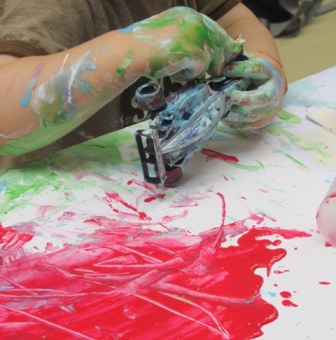
Thursday, February 24, 2011
Monday, February 21, 2011
VALENTINE'S DAY
Young artists love hearts, so for Valentine's day I brought a lot of hearts for the kids to make cards to their loved ones! We glued heartshapes and stickers and drew hearts or used a stencil.
Monday, February 14, 2011
TIP: What to do with an overload of your kid's art projects?
Are you collecting too many of your child's artwork? In a short period of time you might find your home overloaded with drawigns, paintings, crafts and all the art your child is bringing from the kindergarden and the art created at home. So, what should we do with all of them?
Explain to your child that you can't keep them all and choose with them which one's to keep. Remember that what is pretty in your opinion might not be relevant to your kid, so let them make the decisions. That's also a good moment to let them talk about their art if they want to. (More about conversations with kids about their art in a next Tip!)
Make a "portfolio" with the chosen artworks and choose a few projects for displaying and maybe hanging in a simple frame to decorate the child's room.
If the kid wants to keep too many projects and you have to clean out more, please don't let your child find their art thrown in the garbage (it's not an encouraging statement...). Don't feel guilty, though, about throwing them away, since most of the time the process of creating was more important to the child than the final project.
Explain to your child that you can't keep them all and choose with them which one's to keep. Remember that what is pretty in your opinion might not be relevant to your kid, so let them make the decisions. That's also a good moment to let them talk about their art if they want to. (More about conversations with kids about their art in a next Tip!)
Make a "portfolio" with the chosen artworks and choose a few projects for displaying and maybe hanging in a simple frame to decorate the child's room.
If the kid wants to keep too many projects and you have to clean out more, please don't let your child find their art thrown in the garbage (it's not an encouraging statement...). Don't feel guilty, though, about throwing them away, since most of the time the process of creating was more important to the child than the final project.
Friday, February 11, 2011
SCULPTING WITH CLAY
This week we used real clay to make sculptures. First, the kids explored the soft and cool material. It's a little bit more difficult at first to work with than the dough we usually work with because it does need a bit more strength in the hands and arms, but it's a wonderful material to work with. Then I brought out some materials to decorate the clay and the creativity starts flowing!
Finally, the kids asked to draw on the bases of their sculptures to further decorate their creations.
It was a very exciting session full of diverse materials and use of techniques.
Emma and Shira are exchanging thoughts about their art.
Finally, the kids asked to draw on the bases of their sculptures to further decorate their creations.
It was a very exciting session full of diverse materials and use of techniques.
WOOD CONSTRUCTION
First, we started out with making a composition from wood pieces. Using glue, we attached wooden squares and frame corners, babushkas and wooden sticks to make constructions or sculptures.
Then, we used tempera to paint the constructions. Not all of the children wanted to paint their sculptures, so they painted on white paper. Some used their hands, some used sponges and others the classic brush.
Subscribe to:
Comments (Atom)


